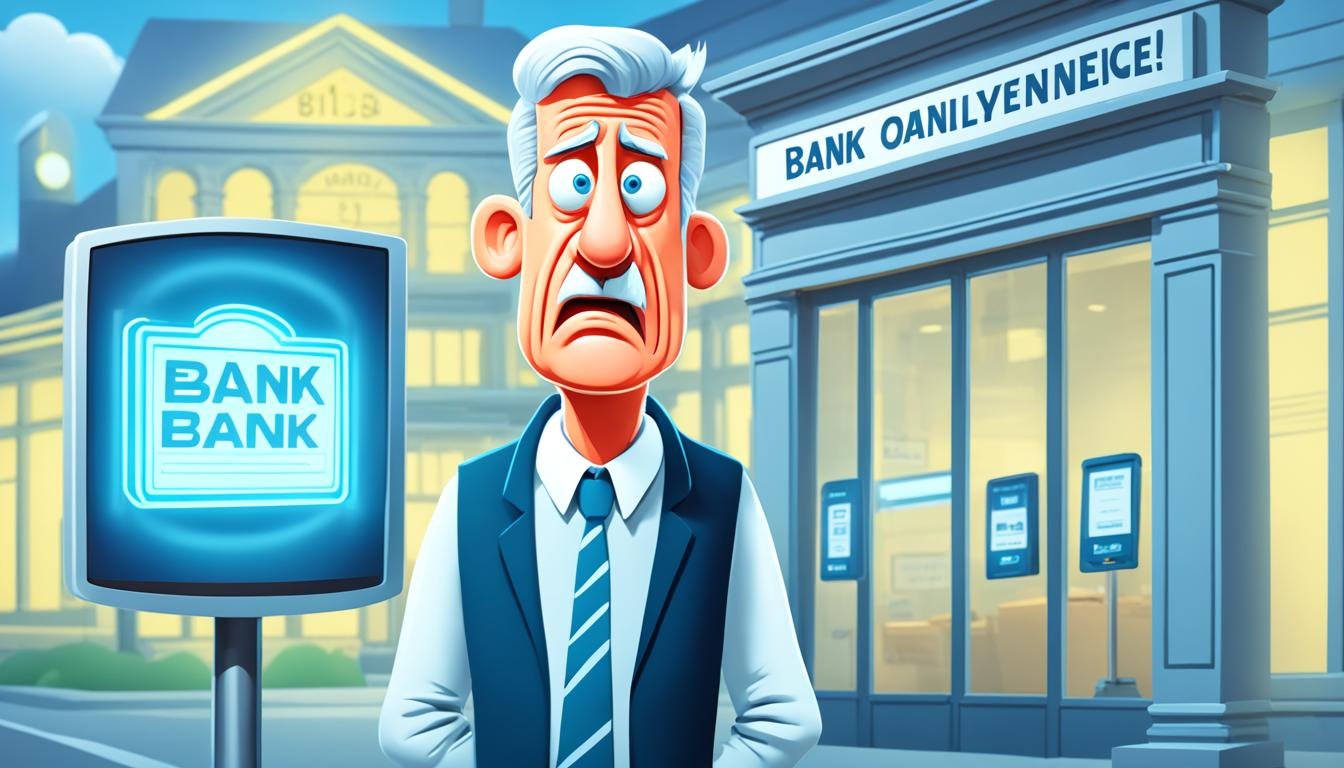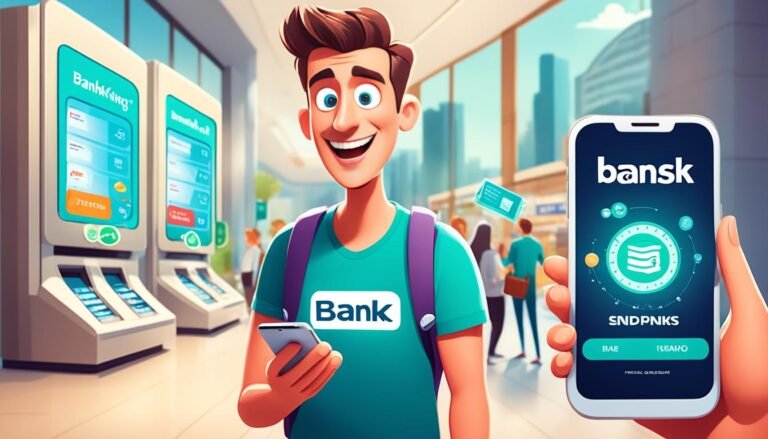Digital-Only Banks: Are Branches Dead? You Might Be Surprised
Today, 76% of Americans bank online. This shows how much we love digital services. Yet, traditional bank branches aren’t disappearing. They’re keeping up, even with all the digital advances. This situation shows both digital and traditional banking have their place. They meet different needs for different people, from those who love the latest tech to those who prefer the old ways.
Even young people sometimes choose to visit banks in person. Digital banks are boosting their security to match. But having the option to bank online or in person makes a big difference. While online banking is super convenient, some people still value the in-person service. This mix of digital and traditional banking shows that each has its own strength.
Key Takeaways
- Many consumers continue to value the in-person services branches offer, indicating they are not yet obsolete.
- Even high-tech Gen Z shows a preference for physical banks, emphasizing the importance of human interaction.
- Digital-only banks and fintech advancements have not completely supplanted the need for traditional banking.
- Both branches and online banking platforms are evolving strategies to address security concerns and maintain customer loyalty.
- With a diverse customer base, the financial industry is finding strength in offering a range of digital and physical banking services.
Branch Versus Digital: The Current Banking Landscape
The banking sector has evolved into two main models. One is branch banking, known for its person-to-person service. The other is digital banking, which highlights technology. Even though many thought physical banks would fade away, the reality is more complex. Both models are shaping the future of banking together.
The Misconception of Branch Banks’ Demise
Some believed digital banking’s rise would end branch banking. Yet, current trends show traditional banking is still strong. People appreciate the personal touch of in-branch services. It builds trust and offers personalized experiences that online platforms can’t match.
Gen Z’s Unexpected Preference for Physical Banks
It’s surprising, but Gen Z prefers traditional banks more than online ones. They value personalized banking experiences. Despite being tech-savvy, they find in-person services better for their intricate financial needs. This shows the lasting value of physical bank interactions.
Quality of Service: In-person vs Online
As banking preferences vary, the focus on service quality grows. Digital banking is valued for its transaction efficiency. On the other hand, branch banking excels in customer experience and personalized help. Thus, banking service quality spans both digital and physical spaces, each serving customers in unique ways.
The discussion is not about one model winning over the other. It’s about finding a balance. This banking landscape combines digital innovation with the personal touch of traditional services. Understanding what customers need is key for banks navigating today’s complex financial services environment.
The Resilience of Branch Banking: More Than Just Transactions
Despite the huge shift to digital, branch banking remains key. It offers something online platforms can’t match – human interaction and deep customer relationships. This personal touch is vital for those needing personalized assistance with complex tasks and big financial choices.
Navigating Complex Financial Needs Face-To-Face
The rise of automation hasn’t diminished the value of meeting in person at bank branches. For complex transactions or financial advice, talking face-to-face matters. Customers discussing mortgages, investments, or retirement plans benefit greatly from these detailed, personal discussions.
The Undeniable Value of Human Interaction in Banking
Human interaction is crucial for building and keeping trust with customers. Banking is so much more than numbers; it’s about the people. Over time, customer relationships grow and become essential. This sets banks that prioritize personal connections apart.
Combining banking services with personal advice increases customer loyalty. It also reassures customers that they have a dependable person to turn to for their financial needs.
| Financial Service | Branch Banking Advantage |
|---|---|
| Investment Advice | Customized portfolio strategies derived from one-on-one conversations |
| Loan Applications | Guided process with a personal banker leads to clearer understanding |
| Complex Transactions | Transactions like foreign wire transfers made simpler with assistance |
| Account Management | Opportunities for relationship banking and tailored account services |
Branch banking doesn’t just survive; it flourishes by offering personalized assistance others can’t. Even as digital options grow popular, the thorough care and expertise of branches are unmatched.
The Rise of Digital-Only Banks and Consumer Adaptation
In the ever-changing world of finance, digital-only banks and neobanks lead the way. They are setting new banking trends and changing what we expect from online banking. By using advanced mobile banking tech, they provide digital banking services that meet the needs of today’s customers. This is a big change in how customers switch to these new options.
Customers are drawn to the ease and access these banks offer. They use their phones for all kinds of banking tasks. Things like depositing checks, moving money, or getting a loan are now easy. This shows that neobanks must stay up-to-date with tech to be successful.
This shift is not just about the tech. It’s also a big change in how people think about and use banking services.
But how have people adjusted to this change? And what does the rise of neobanks say about banking’s future? Looking at recent trends in consumer adoption can give us some answers.
| Year | Neobanks Customer Growth | Adoption Rate Increase |
|---|---|---|
| 2020 | 15% | 10% |
| 2021 | 30% | 25% |
| 2022 | 45% | 35% |
This table shows neobanks’ customer numbers and how quickly new users are joining digital banking services. This growth comes with more services, better user experience, and more trust in fintech.
Users now want more from online banking. Neobanks need to keep improving to keep their customers loyal and active.
In conclusion, the rise of digital-only banks is changing banking worldwide. How customers adapt and how neobanks meet their needs will define the future of banking trends.
Security Concerns: How Both Banking Models Respond
In the banking world today, security is a big deal. Traditional and digital banks are working hard to keep customer data safe. They’re not just fighting to offer the best service or products anymore. Now, they also focus on how well they can protect customers’ information. Keeping data safe is crucial for banks to earn and keep trust in this digital era.
Data Breaches and The Trust Factor in Banking
Data breaches are now common and shake people’s faith in banks. Trust is key between banks and their customers. It affects where people decide to save or invest their money. Banks need to be open about their security steps. They should also educate customers on how to protect their private info.
Authentication and Encryption: Online Banks’ Front Line
Digital banks have a huge job. They must use top-notch ways to confirm who you are and protect your data. This keeps customers’ money and personal info safe from online dangers. The aim is to create a digital space that makes customers feel secure using internet banking.
| Security Feature | Function | Impact on Customer Confidence |
|---|---|---|
| Two-factor Authentication | Requires two types of credentials for account access, adding an extra layer of defense. | Enhances trust as customers feel their accounts are better secured. |
| End-to-end Encryption | Ensures that customer data is scrambled and unreadable to unauthorized users during transmission. | Builds a sense of security for online transactions and sensitive communications. |
| Regular Security Audits | Examines and strengthens existing security measures to close any vulnerabilities. | Increases assurance in the bank’s commitment to safeguarding customer information. |
| Secure Socket Layer (SSL) Certificates | Creates a secure connection between a web server and a browser, protecting data in transit. | Instills customer confidence in the integrity and confidentiality of their data. |
All banks, both physical and online, must keep improving their security to face new threats. It’s important for them to use strong security without making banking hard for customers. Keeping customer information safe is key. It helps banks to grow and survive in the digital world.
When Banks Become Advisors: The Role of Human Contact
In our fast-moving digital world, the finance sector is changing deeply. Banking relationships and customer support are more important than ever. Despite the digital boom, the need for human contact hasn’t faded, especially for personalized financial advice. The demand for financial advisors and personal banking assistance remains strong and is getting more diverse.
Clients now desire a mix of digital convenience and expert guidance. This combination boosts the value of financial services. It creates a perfect blend of ease and personalized care, leading to solid, enduring banking relationships.
Considering the crucial role of human touch in banking, let’s explore the benefits of combining digital tools with personal advice from financial advisors:
| Banking Feature | Impact of Digital Resources | Enhancements from Human Advisors |
|---|---|---|
| Account Management | 24/7 access, real-time updates | Explanation of features, personalized setup |
| Investment Strategies | Automated portfolio tools, market data | Custom strategies, risk assessment |
| Risk Analysis | Standard risk models, algorithmic predictions | Human insight, tailored advice |
| Life Events Planning | Online calculators, applications | Empathetic guidance, situational recommendations |
| Customer Support | Chatbots, FAQ sections | Personalized assistance, proactive concern |
The combination of modern tech and advisor wisdom is powerful. This model offers varied solutions, catering carefully to each client’s needs. It shows that in our digital world, the personal touch of human contact is crucial. It helps clients understand their financial journeys better.
The mix of personalized financial advice, customer support, and high-tech tools symbolizes banking’s future. It highlights how digital services ease transactions while financial advisors provide crucial personal insights. Advisors make banks truly valuable partners in managing wealth.
Digital Banking Services: Limitations and Misconceptions
The world of digital banking services is always changing. It gives customers convenience unseen a decade ago. However, as more people use these technologies, we see big limitations. These issues affect customer support and how clients handle banking challenges during financial crises. Knowing these limitations helps us clear up wrong ideas about digital banking’s power.
Online Banks: Hurdles in Personalized Assistance During Crises
When people face financial trouble, they really see the value in personalized assistance. Traditional banks have given this kind of help for years, thanks to their face-to-face services. In contrast, digital banking services are quick and simple but have a hard time when customers need a personal touch. They struggle to provide the deep and caring help needed in tough financial times. This can make customers unhappy and feel they’re not getting good customer support.
Delayed Funds Access: A Digital Dilemma
Users of digital banking services often face delays in funds access. Nowadays, when instant transactions are expected, any delay is a big problem. Delays can be caused by technical issues, security measures, or system problems. This can badly affect how users see their digital bank’s reliability when they need money fast.
| Aspect of Digital Banking | Customer Expectation | Real-life Limitation |
|---|---|---|
| Personalized Support in Crises | Timely, tailored support | Limited by automated systems, lack of human interaction |
| Real-time Funds Access | Instant transactions and withdrawals | Potential delays in processing, technical issues |
| 24/7 Customer Service | Anytime access to support | Generic automated responses, wait times for live help |
In summary, digital banking services make many daily transactions easier. But they come with limitations. Whether it’s offering personalized assistance during financial crises or ensuring quick funds access, these banking challenges are areas needing innovation and improvement.
The Phenomenon of Digital Banking and Financial Milestones
Digital banking has started a new chapter in how we handle money. It changes the way customers make big life purchases. As online banking becomes more common, it’s crucial to explore its impact on loans and what people prefer.
Navigating Major Life Purchases Virtually
The way we make financial decisions has changed a lot because of digital banking. It lets people buy homes or pay for college much more easily. With virtual banking, you get the latest info and can complete transactions quickly. This not only makes it easier to buy big things but also helps people grab financial chances as they come.
Comparing Digital and Traditional Lending Experiences
Old-school lending meant meeting in person and lots of paperwork. Now, digital banking offers a quicker, smoother process. People like this better because it’s fast and easy. Yet, the personal advice and connection you get from traditional banking are still important. This makes digital lenders think of new ways to add a personal touch to their services.
Let’s look at the differences between digital and traditional bank lending:
| Digital Banking Lending | Traditional Banking Lending |
|---|---|
| Quick online application process | Personal interaction and guidance |
| Automated decision-making algorithms | Manual underwriting with possible negotiation |
| Immediate feedback on loan approval | Longer wait times for approval |
| 24/7 access to loan status and account management | Limited access based on branch hours |
Nowadays, lending has evolved because people do more online. Still, not everyone likes the same thing. That’s why a mix of online banking efficiency and the personal touch of traditional advice works best. This way, both methods help with the big financial moments in our lives.
Challenges in Urgent Situations: Branches as a Safety Net
In today’s banking world, unexpected urgent situations can happen at any time. This requires quick and effective solutions. Though online banking is convenient, branch banking is crucial as a safety net in these moments. For many facing banking emergencies, getting help in person is essential.
Think about this: a person finds fraudulent charges on their account. This is something that needs fast action. Or maybe someone can’t use their banking app when they need to make an important payment. Here, the human touch and problem-solving of traditional branches are unmatched.
Branch banking shines when people need quick access to their money or have to solve complicated issues fast. The physical presence of a bank, a financial advisor’s reassuring handshake, and face-to-face meetings are invaluable during such times.
Here’s a table showing typical urgent situations in banking, and how branch and online services respond.
| Urgent Banking Situation | Branch Response | Digital Platform Response |
|---|---|---|
| Fraudulent Activity | Immediate freeze of account, in-person reassurance, and quick initiation of dispute resolution process | Online notification and support ticket, possibly delayed response depending on the hour |
| Lost or Stolen Card | Instant issuance of a temporary card and help with setting up new account safeguards | Remote card cancellation through app, possible wait for a new card delivery |
| Complex Financial Approval | Discussion with bank officials and immediate assessment, leverage in-person negotiation | Email or chatbot assistance, typically standardized and less flexible |
| Emergency Fund Access | Facilitate immediate withdrawal or loan with on-the-spot approval processes | Online forms and potential processing wait times |
In conclusion, even though online banking is handy, there’s still a strong need for in-person assistance in urgent situations. Branch banking acts as a crucial safety net during banking emergencies. It offers a unique layer of support that strengthens the banking system’s trust and stability.
Conclusion
In the fast-changing banking landscape, digital-only banks have made a big impact. They promise more convenience and easy access. Yet, it’s a mistake to think old-school branches are outdated. They still offer something very special: personalized service and human interaction. Traditional banks meet various customer preferences, showing there’s no one-size-fits-all in finance.
Some say digital banks will take over. But many people still prefer personalized service and human contact. This shows banks must combine digital efficiency with the personal touch of physical banking. This mix builds trust, especially important today when we worry about security and data safety.
Going forward, we’ll need both physical and online banks. They’re both critical for a full-service financial ecosystem. By bringing together their strengths, banks can keep up with changing needs and focus on their customers. So, the future of banking isn’t choosing between digital-only banks and branches. It’s about creating a banking experience that’s both secure and customer-focused, combining the best of both worlds.
FAQ
Are branch banks becoming irrelevant in the digital era?
Do Gen Z customers prefer physical banks?
What is the difference in service quality between in-person and online banking?
Why are digital-only banks gaining popularity?
How do traditional and digital banks address security concerns?
What role does human contact play in banking?
What are the limitations of digital banking services?
How does digital banking impact major life purchases?
What is the role of branches in urgent situations?
Source Links
- https://www.rivel.com/newsroom/banking-research/branch-banking-is-not-dead
- https://www.linkedin.com/pulse/theres-future-bank-branches-because-theyre-already-dead-gary-whyton
- https://www.forbes.com/sites/ronshevlin/2021/09/28/new-study-gen-z-and-millennials-use-bank-branches-because-of-a-poor-digital-experience/







